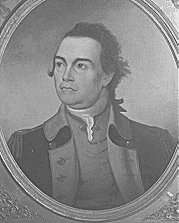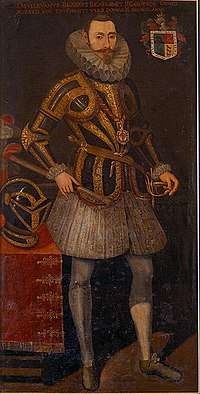Donal Cam O'Sullivan Beare
Donal Cam O'Sullivan Beare, Prince of Beare, 1st Count of Berehaven (Irish: Domhnall Cam Ó Súileabháin Bhéara) (1561–1618), was the last independent ruler of the O'Sullivan Beara sept, and thus the last O'Sullivan Beare, a Gaelic princely title, on the Beara Peninsula in the southwest of Ireland during the early seventeenth century, when the English Crown was attempting to secure their rule over the whole island.
Early life
Donal's father was killed in 1563, but he was considered too young to inherit and the clan leadership passed to the chief's surviving brother Eoin, who was confirmed by English authorities in Dublin with the title Lord of Beare and Bantry. To consolidate his position, Eoin accepted the authority of Queen Elizabeth I of England and was knighted, thus becoming Sir Eoin. In 1587, Donal asserted his own claim to leadership of the clan, petitioning Dublin Castle to put aside Sir Eoin's appointment with a claim derived from English laws based on absolute male primogeniture. These laws did not recognise age as relevant to inheritance rights. Keen to extend English legal authority over Ireland, the Dublin commission accepted Donal's claim. He now became The O'Sullivan Beare, head of the clan.
Nine Years War
By 1600 Munster had been devastated by battle, and the Gaelic clans lost over half a million acres (4,000 km²) of land to settlers from England following the defeat of the Desmond Rebellions.[1]
In the lead up to the Nine Years' War O'Sullivan kept his distance from the rebel cause, but in time he joined a confederation of Gaelic chiefs led by Hugh O'Neill, 3rd Earl of Tyrone, An Ó Néill, and Red Hugh O'Donnell, An Ó Domhnaill, of Ulster. Conflict had broken out in 1594, and Lord Tyrone secured support from King Felipe II of Spain. The Spanish sent a force under the command of Don Juan D'Aquilla in 1601. O'Sullivan wrote to the Spanish king in submission to his authority, but the letter was intercepted by the English. In early 1602 the allied Irish and Spanish forces met the English at the Battle of Kinsale and were defeated.
O'Sullivan resolved to continue the struggle by taking control of the castle of Dunboy. In June 1602 English forces attacked Dunboy and the castle fell after a vicious siege. The entire company of defenders was killed in combat or executed.[2]
O'Sullivan's march
Donal himself was absent from the siege of Dunboy, having travelled to Ulster for a conference with Lord Tyrone. His letter to Philip left him with little hope of a pardon from the English, and he continued the fight with guerilla tactics.
He concealed 300 of the women, children and aged of his community in a stronghold on Dursey Island, but this position was attacked, and the defenders hanged. In what was later termed the Dursey Massacre, Philip O'Sullivan Beare (c.1590-1660; nephew of Donal Cam O'Sullivan Beare) wrote that the women and children of the Dursey stronghold were massacred by the English, who tied them back-to-back, threw them from the cliffs, and shot at them with muskets.
After the fall of Dursey and Dunboy, O'Sullivan Beare, Lord of Beara and Bantry, gathered his remaining followers and set off northwards on a 500-kilometre march with 1,000 of his remaining people, starting on 31 December 1602. He hoped to meet Lord Tyrone on the shores of Lough Neagh.
He fought a long rearguard action northwards through Ireland, through Munster, Connacht and Ulster, during which the much larger English force and their Irish allies fought him all the way. The march was marked by the suffering of the fleeing and starving O'Sullivans as they sought food from an already decimated Irish countryside in winter. They faced equally desperate people in this, often resulting in hostility, such as from the Mac Egans at Redwood Castle in Tipperary and at Donohill in O'Dwyer's country, where they raided the food store of The 10th Earl of Ormond. O'Sullivan marched through Aughrim, where he raided villages for food and met local resistance. He was barred entrance to Glinsk Castle and led his refugees further north. On their arrival at The O'Rourke's castle in West Breifne on 4 January 1603, after a fortnight's hard marching and fighting, only 35 of the original 1,000 remained. Many had died in battles or from exposure and hunger, and others had taken shelter or fled along the route. O'Sullivan Beare had marched over 500 kilometres, crossed the River Shannon in the dark of a midwinter night (having taken just two days to make a boat of skin and hazel rods to carry 28 at a time the half-kilometre across the river), fought battles and constant skirmishes, and lost almost all of his people during the hardships of the journey.
In County Leitrim, O'Sullivan Beare sought to join with other northern chiefs to fight the English, and organised a force to this end, but resistance ended when Lord Tyrone signed the Treaty of Mellifont. O'Sullivan, like other members of the Gaelic nobility of Ireland who fled, sought exile, making his escape to Spain by ship.
The Beara-Breifne Way long-distance walking trail follows closely the line of the historical march.
Exile
When he left Ireland, Cornelius O'Driscoll and other Irish knights helped him and his clan. In Spain, O'Sullivan Beare was welcomed by H.M.C.M. King Felipe III. His princely status was reconfirmed, and he received a commission as an imperial general. His nephew, Philip O'Sullivan Beare, was important in this regard and his 1618 disquisition in Latin, A Briefe Relation of Ireland and the diversity of Irish in the same, was influential.[3]

In 1618, The O'Sullivan Beare, Prince of Beare and 1st Count of Berehaven, was murdered just as he was leaving Mass in the Plaza de Santo Domingo in Madrid. The murderer was John Bathe, a Dublin Englishman who had been disfigured in a duel by the prince's nephew, on account of some arguments between Bathe and O'Sullivan; it is also said that the man was a spy on behalf the English Crown.
The O'Sullivan Beare enjoyed a wide reputation, which helped to open doors for later soldiers from his line. About 165 years later, John Sullivan, regarded as a descendant of O'Sullivan Beare, served as a general in the American Revolution.
See also
In popular culture
- The Last Prince of Ireland by Morgan Llywelyn
- March into Oblivion by Michael J. Carroll
- O'Sullivan's Odyssey by Rick Spier
References
- ↑ http://www.theirishstory.com/2015/09/30/the-desmond-rebellions-part-ii-the-second-rebellion-1579-83/#.WRHRc-lTGmS
- ↑ O'Sullivan and castletown
- ↑ https://web.archive.org/web/20050330160649/http://www.ucc.ie/acad/classics/CNLS/lectures/Morgan_madrid.html. Archived from the original on 30 March 2005. Retrieved 30 October 2009. Missing or empty
|title=(help)
